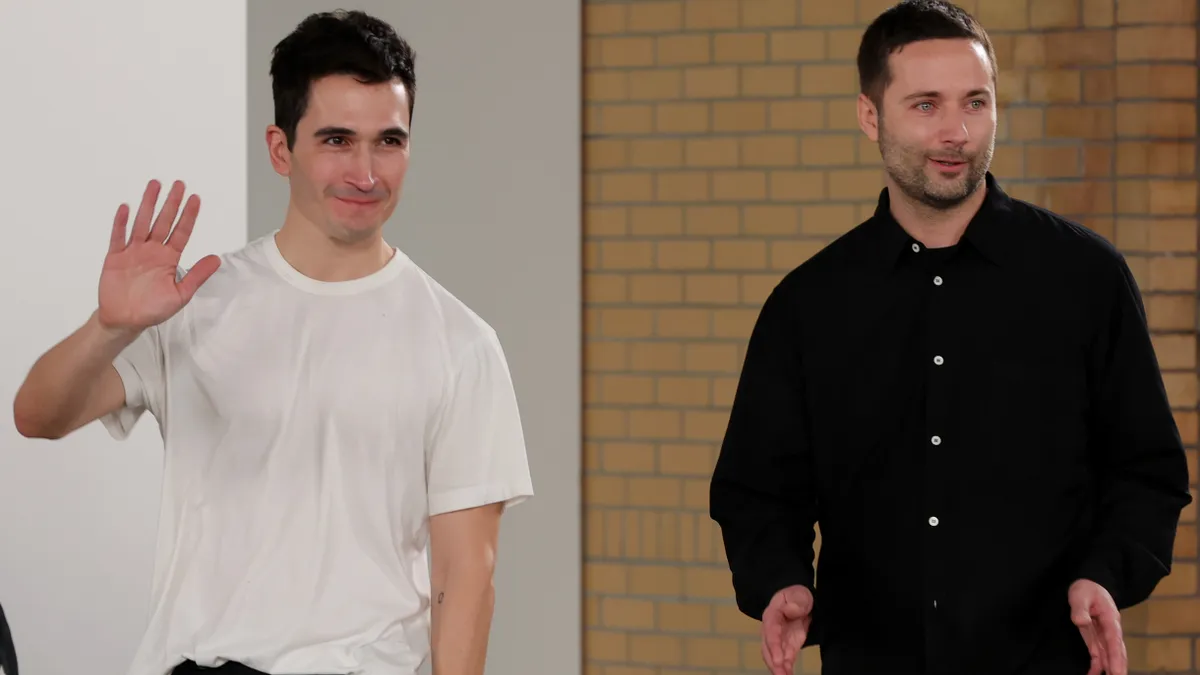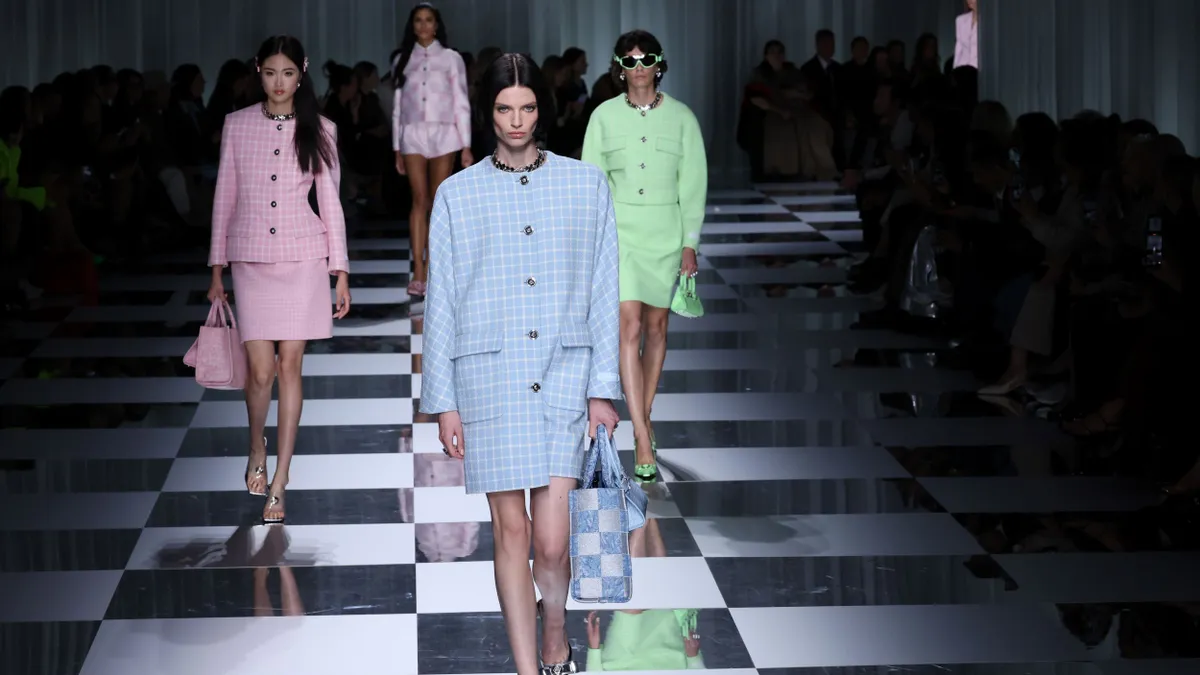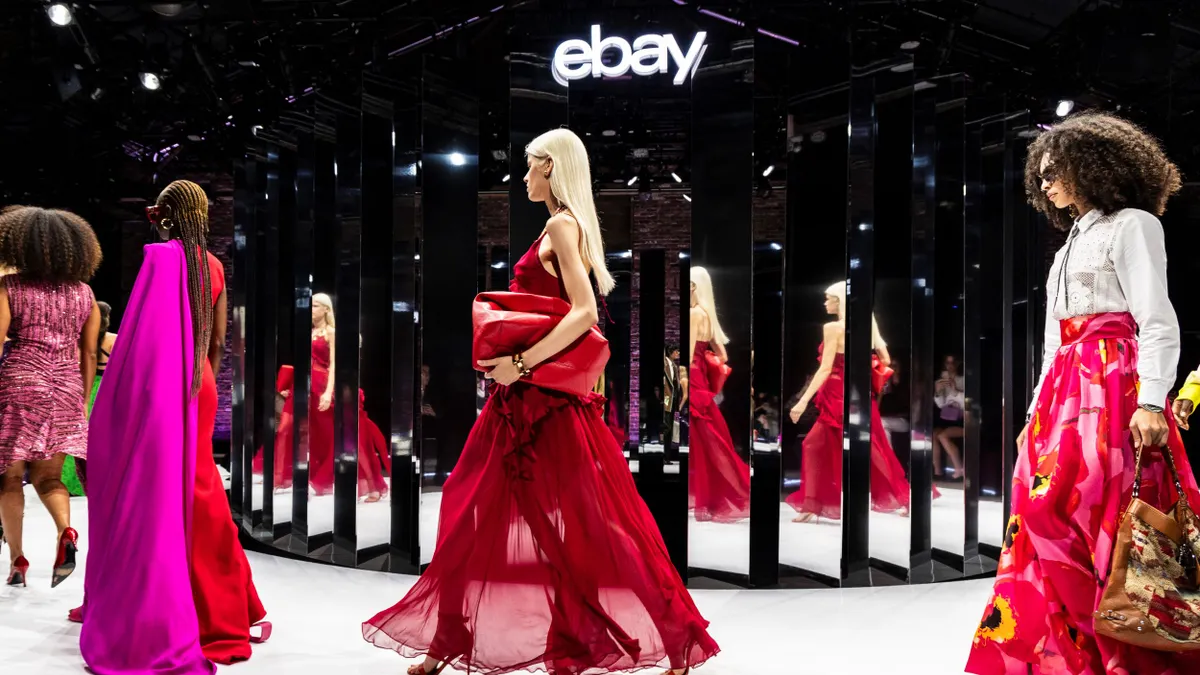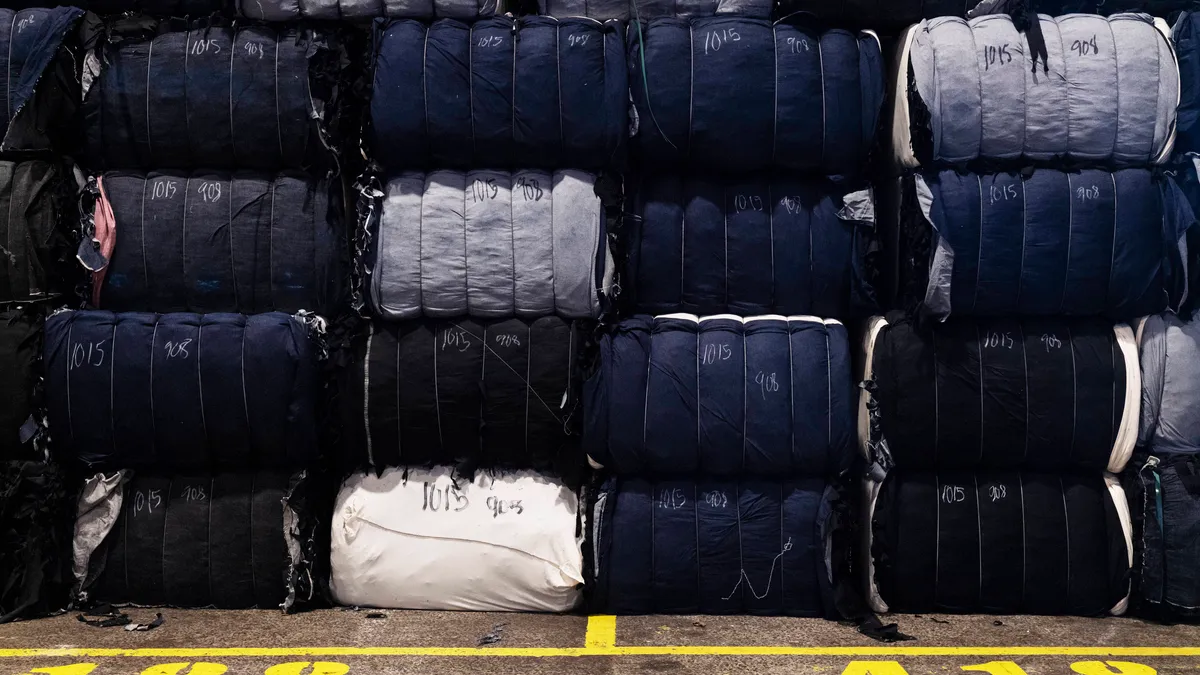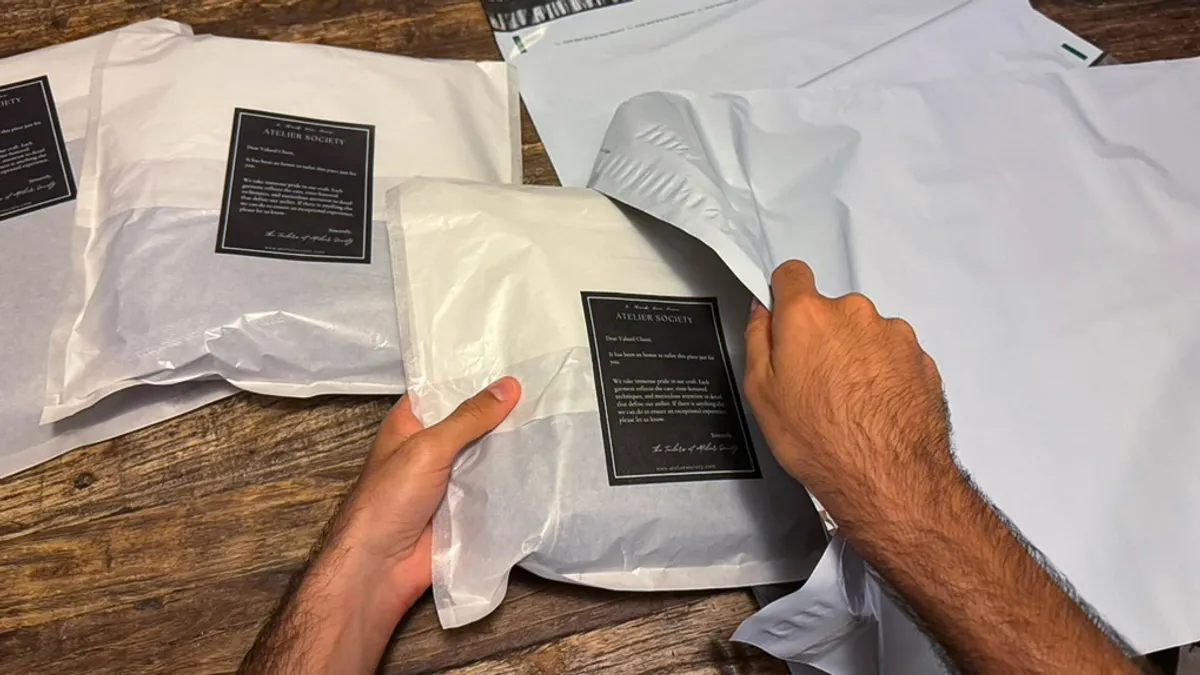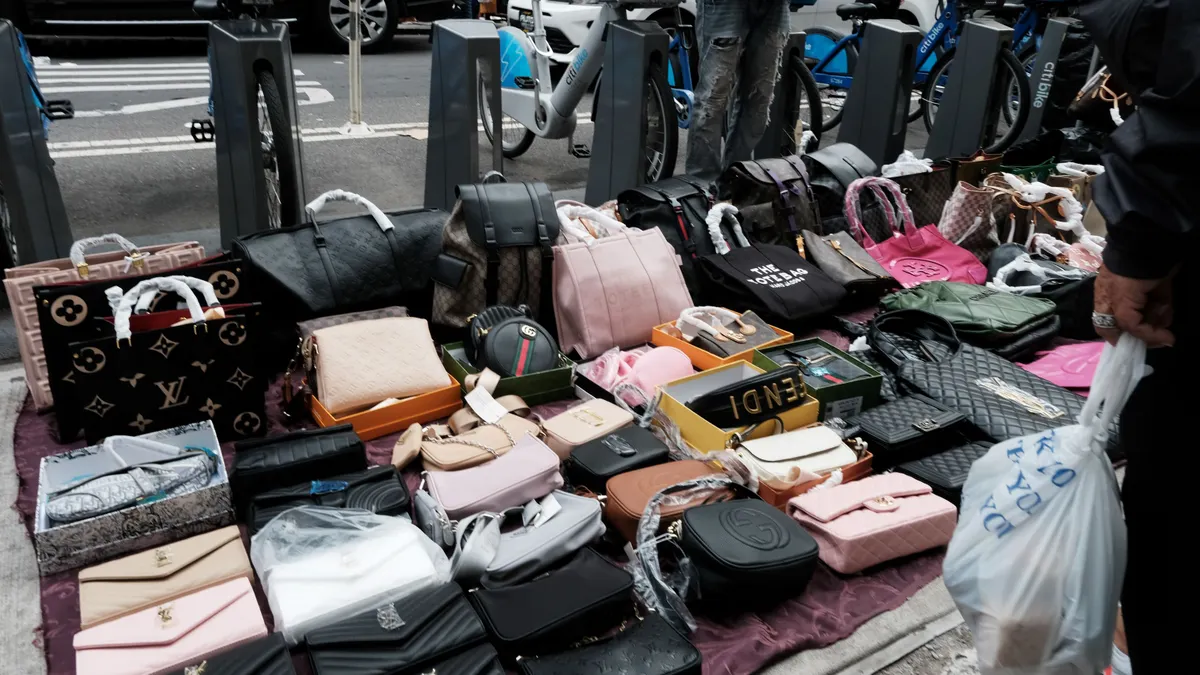As another election year begins, the fashion industry is battling economic headwinds while continuing to navigate consumer demand for fresh looks and new ideas.
At the same time, brands are increasingly being held accountable for every step in their manufacturing journey from both consumers demanding transparency and governmental regulations in the U.S. and abroad.
However, this increased responsibility has created a new kind of power play, as larger companies look to control their supply chains and DTC retail operations and acquire smaller companies and brands that dovetail with their creative vision and financial goals.
Although luxury spending is slowing down after years of pandemic-fueled shopping, the category is experiencing more of a normalization than a retraction. Meanwhile, newer fast fashion firms are challenging the status quo, sometimes to their own detriment.
Here are some of the biggest trends that will affect the industry in 2024.
Clothes get quieter (and a little louder)
Consumers reset their expectations about what they wanted from fashion in 2023 as quiet luxury took center stage while some of fashion’s biggest houses began to see revenue downturns.
“Tolerance for over-inflated goods is going down,” Benjamin Smithee, CEO of business consultancy firm The Smithee Group, said in an email. He added that he’s seeing this happen in watches and timepieces as a result of not only the current economic climate, but also consumer anticipation of future downturns.
Consumers continue to move away from ostentatious displays of branding and toward subtler styles. To wit, lowkey items such as Miu Miu’s intarsia logo cardigan, priced at more than $1,800, consistently sold out, as did Uniqlo’s mini half-moon shoulder bag, which cost about $20. The Lyst Index for 2023 noted both items, along with Loewe’s swirling graphics, Adidas’ Samba sneakers and Telfar’s tonal initials, as some of the year’s biggest hits, and of them showcase a fashion sensibility that’s growing increasingly understated.
Clothing will keep getting casual at work and while traveling. Offices are relaxing workplace attire rules, and while Smithee said government, banking and legal professions are among the last holdouts when it comes to suits and ties, he sees even formal workplaces evolving.
“I doubt we will see [offices] go completely street fashion, but as the younger workforce comes of age there will be changes,” he said, adding that as long as “celebs are flying private in sweats and athleisure, the mainstream is going to follow suit.”
When it's time to dress up, though, fashion will go all out. Expect bold colors, dramatic monochromes and big runway looks to show up at celebrations throughout the coming year, from awards shows to proms.
Luxury and mass market collabs
2023 was a big year for collaborations in fashion, and the trend is expected to continue into the new year.
Individual designers launched lines with mass market stores, including Willy Chavarria, who collaborated with Pacsun on a line of tee shirts and hoodies as well as with VF Corp.-owned Dickies on a workwear collection. Former Givenchy creative director Clare Waight Keller also launched a collection for Uniqlo, and Peter Do collaborated with Banana Republic.
Collaborations such as these challenge traditional perceptions of luxury and can serve as a creative tool to reach new consumer groups, said Nora Kleinewillinghoefer, partner at Kearney. The collaborations make luxury both accessible and aspirational, she said.
However on the flip side, brands should exercise caution on these collaborations to mitigate what Kleinewillinghoefer called potential damage to prestige and a misalignment in brand identity. She said this could create a dilution of exclusivity and consumer confusion if the novelty of the partnership wears off.
In 2023, Forever 21 collaborated with Barneys New York, a once-storied high fashion department store, on a 32-piece capsule collection, which ranged in price from $29.99 to $129.99. Company leaders said the collaboration was an effort to “bring high fashion to a new generation of consumers.” Though not a luxury brand, Forever 21 also collaborated with the higher-priced Nine West on a line of shoes in what Winnie Park, CEO of Forever 21 said was a bid to attract multiple generations.
“Heading into 2024, this trend is not just continuing, it's growing,” Kleinewillinghoefer said in an email to Fashion Dive. “It's about generating impressions, penetrating new price points, and fostering cross-pollination of ideas and consumer bases.”
Company consolidation
In its recent State of Fashion 2024 report, McKinsey said “about 98 percent of the luxury segment’s total economic profit was generated by the four largest players,” while 81% of the total economic profit in the fashion business was generated by the top 10 companies.
Throughout 2023, the industry got more concentrated through mergers and acquisitions including Tapestry buying Capri and Coupang announcing its plan to buy Farfetch. Authentic Brands Group bought multiple struggling brands,creating further consolidation. In addition, venture capital became scarcer, creating financial challenges for smaller independent brands.
In the coming year, these trends will intensify, Joëlle Grünberg, partner in McKinsey’s Apparel, Fashion and Luxury Practice, said in an email.
“We do expect further consolidation in the US as some players are underperforming in the market and struggling to stay afloat,” she said. Companies have been “running out of cash and/or pressured by the street and activists to quickly improve their performance or even sell part of their business,” Grünberg said, noting that high inventory levels and margins “pressured by promotions” have intensified the problems.
As a result, the industry can expect to see an increased industry contraction in 2024. “Some big moves have already been announced, we certainly expect others to come in the next months,” Grünberg said.
Smaller brands may also have a hard time raising cash. “While a couple of them are able to quickly scale and finance their growth, many are looking for funding and are not finding any more open doors,” Grünberg said.
“All of our analysis shows it’s a winner takes all industry where the bigger players capture most of the economic value thanks to their branding power, product innovation engine and strong control on distribution online or offline,” Grünberg said. “It is increasingly difficult for brands to build awareness given the marketing investments put in by the existing players.”
Brands use tech to crack down on fakes
In 2023, Christian Louboutin and Meta filed a joint lawsuit against an alleged counterfeiter over the sale and advertising of counterfeit goods on Facebook and Instagram. Similarly, Amazon and the Prada Group collaborated to gather evidence against an alleged counterfeiter in China, which resulted in a court win.
While such fashion and tech collaborations weren’t new — Amazon and Valentino jointly sued an alleged counterfeiter in 2020 — more fashion companies could collaborate with tech companies on cases like these in the new year.
Brands have recently gone to great lengths to protect their copyrights, trademarks and other intellectual property rights, among them Adidas, Temu and New Balance.
AI and other forms of technology are also being used in the resale process to verify the authenticity of items.
Resale and DTC reshape wholesale
As several fashion companies saw decreased wholesale numbers in 2023, resale and DTC have seen increased interest.
Resale is a growing niche that appeals to a specific but expanding consumer base, said Benjamin Bond, principal in the consumer practice of Kearney. However, he said it hasn’t yet become a major disrupter of traditional retail.
Resale is gaining ground. A 2023 report from resale platform ThredUp estimated that the U.S. secondhand market could reach $70 billion by 2027, and the market globally could reach $350 billion in the same year. The U.S. apparel market as a whole was estimated to be about $556.1 billion in 2022, according to data from GlobalData.
AI may also be used more in resale in the coming year, according to Gayle Tait, CEO of resale platform Trove.
“AI allows for scale in resale due to the complexity of managing a commerce channel enabled by millions of single SKUs with residual values that cannot be assigned sight unseen, requiring technology and instrumentation for real-time, dynamic decision-making,” Tait said in an email to Fashion Dive.
“Machine learning and the recognition of items allow us to understand how much an item is worth,” Tait said. “For example, if there is a hole in a jacket, we can leverage AI to recognize the item as a $50 or $400 jacket, and use data to determine how much time can be spent on repair and the resale value. In short — data is leveraged to immediately identify and categorize what can be resold and for how much.”
Though it’s growing, resale isn’t expected to disrupt brand’s wholesale numbers, but Bond said it could help brands unlock new customer segments and boost brand loyalty.
“Despite its transformative potential, the scaling of resale in fashion is hindered by complexities in quality assurance, authentication struggles, and the challenges with single intake supply chains,” Bond said in an email to Fashion Dive. “This slow growth continues to limit the impact on existing channels.”
DTC, however, has “shaken up” the wholesale model, while many digital-first brands are discovering the necessity of wholesale to effectively scale, per Bond. He said DTC was critical for a brand’s expression and building consumer relationships.
“Expect a rise in DTC-only exclusive products, coupled with robust loyalty offerings,” Bond said. “This will challenge wholesale on pricing and exclusivity, yet there remains ample room for collaborative success.”
Though DTC is growing in its penetration, Bond said it has “natural limits due to where consumers shop.”
“The majority of retail volume continues to be with mass players and brick-and-mortar,” Bond said. “This preference is driven by factors like the convenience, and immediate availability. This is not to undermine the significance of DTC in the current retail landscape but to acknowledge that its growth is capped by the prevailing consumer inclination towards traditional shopping venues.”
Increased accountability
In the U.S. and abroad, lawmakers are pushing fashion to become more sustainable and more ethical. That’s only going to intensify in 2024 and beyond as regulations that were passed in previous years take effect.
The New York Fashion Act, which will be taken up in the 2024 legislative session beginning in January, is one of those bills. If passed, it will require companies with global revenues of more than $100 million to disclose and be held accountable for supply chain practices, taking into account environmental and human rights concerns. It proposes fines of up to 2% of a company’s annual revenue, and the fines collected would go toward helping affected workers and financing environmental projects.
Meanwhile, Sen. Kirsten Gillibrand, D-N.Y., formally reintroduced the Fashioning Accountability and Building Real Institutional Change Act to the U.S. Senate in September. The revised legislation, which has more than 200 brand, labor union, and nonprofit endorsements, would hold brands and manufacturers accountable for wage violations, eliminate piece rate pay and create a $50 million per year domestic manufacturing program.
In Europe, measures including the Corporate Sustainability Reporting Directive, the Due Diligence Directive and the Ecodesign for Sustainable Products Framework are all set to come into effect within the next five years, meaning that any company doing business on the continent will need to start preparing for these changes now. Looking further ahead, the EU Strategy for Sustainable and Circular Textiles, adopted in 2023, will take effect by 2030.
Companies that have not already begun to assess and clean up their supply chains, particularly for their tier 1 and tier 2 suppliers; or plan for the afterlife of their goods; or address any lingering lack of transparency may already be behind. Despite the appeal of an easy way out, alternative materials, no matter how fantastical, won’t be enough to fix 2024’s ESG challenges for companies that aren’t prepared to make drastic changes.
Politics will matter
Politics will be at the forefront throughout the year, due to both the upcoming U.S. presidential election and the ramp-up to the U.K. general election. In an already tense political climate, polarizing viewpoints from companies and consumers could create a volatile space for the fashion industry.
Because of the potential for problems, executive consultant Mark Lipton, a former graduate professor of management at The New School and Parsons School of Design, said brands need to stay impartial in the coming year.
“To the extent you firmly believe you understand your market segments' political preferences, the odds of getting this wrong are enormous,” Lipton said in an email. “And even if you are accurate, the incendiary, no-holds-barred political climate we're expecting may motivate pundits for opposing candidates to ‘out’ your position, use it against you in the media, and create a harmful persona of your brand.”
He urged brands to take the high road.
“Engage thoughtfully with your market, and never take a position on a controversial topic, as righteous as it may seem,” he said. “You might have been able to do this twenty — or even ten — years ago, but not now.”
This will be especially important when political conversations are at odds with day-to-day events.
“In reality, a disproportionate number of economists predict a decent 2024 with interest rates dropping, wages rising, and unemployment falling further,” he said. “Leaders of fashion brands will need to navigate inconsistent messaging from candidates and integrate consumer sentiments.”
In addition to the economy, candidates will be talking about labor challenges at home and abroad.
“The political left will continue to call out the industry on mediocre employee relations, while the right will all but ignore it,” said Lipton. He suggested fashion brands find messaging that address these issues. “What corporate feel-good story can you tell that conveys a strong sense of employee concern and equity while having the added benefit of being the truth?” he asked.
Language will be key when it comes to navigating generational divides, especially between Gen Z, Millennials and Gen X, said Lipton.
“Do not fear the wokeness label,” he added, while cautioning brands that they can use alternative language in marketing, but only as long as it’s consistent with their company’s values and beliefs.




